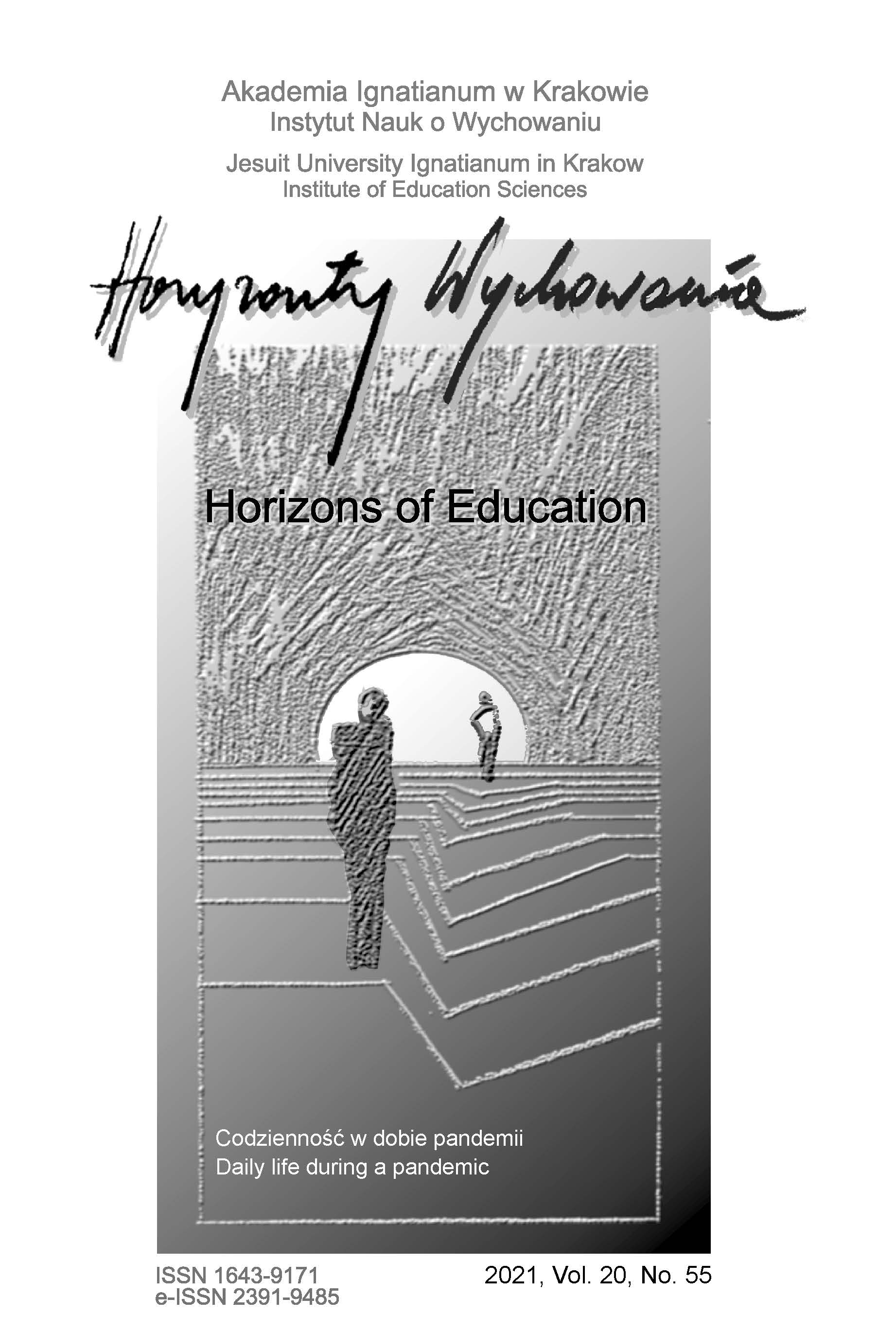The Phenomenon of Invisibility in the Era of Distance Teaching as an Unprecedented Test of Co‑responsibility in Education
Abstract
RESEARCH OBJECTIVE: The aim of this paper is to present and discuss multifaceted issues of the phenomenon of pupil “invisibility” at the time when system teaching was first implemented in the form of distance teaching.
THE RESEARCH PROBLEM AND METHODS: The main problem of the publication is to capture and consequently present the multifaceted nature of the phenomenon of student “invisibility” in the era of distance teaching. The factor initiating the presented considerations was the author’s experience immersed in a specific fragment of the educational reality. An exploratory strategy (based on analysis) was applied to the discussed issue questions about its essence, specificity and struc‑ ture, and to reading the sense and meaning of the observed phenomena.
THE PROCESS OF ARGUMENTATION: In the introduction, the mode of communication during e‑learning activities was described, thanks to which it became possible to show the issue of com‑ municative opacity and the related student invisibility. In the following sections, invisibility is shown as a need, danger, and an unprecedented test of contemporary education, which often supersedes the existence of a consciously co‑responsible approach to learning and teaching.
RESEARCH RESULTS: The final analysis of the discussed phenomenon quite unexpectedly redi‑ rects the recipient from the phenomenon of invisibility to the problem of lack of student and teacher co‑responsibility. This specific deficit of feeling co‑responsibility is presented as a main reason for the “low score” for distance teaching.
CONCLUSIONS, INNOVATIONS, AND RECOMMENDATIONS: This publication points to the need to cultivate a sense of didactic and upbringing co‑responsibility, the occurrence of which in the era of distance teaching could become equal to solving the undesirable phenomenon of invisibility in the era of distance teaching.
References
Aronson, E., Wilson, T.D. iAkert, R.M. (1997). Psychologia społeczna. Serce i umysł (A. Bezwińska-Walerian, tłum.). Wydawnictwo Zysk i S‑ka.
Centrum Cyfrowe. (2020). Edukacja zdalna w czasie pandemii. Raport z badań. (2020). https://centrumcyfrowe.pl/wp-content/uploads/sites/16/2020/05/Edukacja_zdalna_w_czasie_pandemii.pptx-2.pdf
Coleman, L.H., Paternite, C.E. i Sherman, R.C. (1999). A reexamination of deindividuation in synchronous computer‑mediated communication. Computers in Human Behavior, 15(1), 51‑65. DOI: 10.1016/S0747-5632(98)00032-6
Dobek‑Ostrowska, B. (2002). Podstawy komunikacji społecznej. Wydawnictwo Astrum.
Furedi, F. (2009). Culture of fear. Risk‑taking and the morality of low expectation. Continuum.
Gawlik‑Kobylińska, M. (2014). Komunikacja w nauczaniu zdalnym na przykładzie platformy LMS ILIAS. Journal of Science of the Gen Tadeusz Kosciuszko Military Academy of Land Forces, 4(174), 5‑14. DOI: 10.5604/17318157.1143814
Gomóła, A. (2008). Anatomia wstydu, czyli „Opowiadanie o niewidzialnym dziecku”. W: E. Kosowska, G.Kurylenka, Ai . Gomóła (red.), Wstyd w kulturze: kolokwia polsko‑białoruskie (t. 2, s. 147‑160). Wydawnictwo Uniwersytetu Śląskiego.
Ingarden, R. (1987). Książeczka o człowieku. Wydawnictwo Literackie.
Jansson, T. (1990). Opowiadania z Doliny Muminków. Nasza Księgarnia.
Krajewski, M. (2019). Wstęp. Deindywiduacja. W: M. Krajewski (red.), Deindywiduacja. Socjologia zachowań zbiorowych (s. 7‑20). Fundacja Bęc Zmiana.
Kujawski, J. (2018). Wykluczenie cyfrowe jako forma wykluczenia społecznego. Przypadek Polski. Media i Społeczeństwo, 9, 252‑260.
Musierowicz, M. (1991). Brulion Bebe B. Nasza Księgarnia.
Nęcki, Z. (2000). Komunikacja międzyludzka. Antykwa.
Pauluk, D. (2021). Pandemia COVID‑19 i (nie)wykorzystany potencjał edukacyjny. Horyzonty Wychowania, 20(53), 39‑48. DOI: 10.35765/hw.1963.
Plebańska, M., Szyller A., i Sieńczewska, M. (2020). Edukacja zdalna w czasach COVID‑19. Raport z badania. Warszawa: Wydział Pedagogiczny Uniwersytetu Warszawskiego. https://kometa.edu.pl/uploads/publication/941
Postmes, T., Spears, R. i Lea, M. (1998). Breaching or building social boundaries? SIDE‑effects of computer‑mediated communication. Communication Research, 25(6), 689‑715. DOI: 10.1177/009365098025006006
Ptaszek, G., Stunża, G.D., Pyżalski, J., Dębski, M. i Bigaj, M. (2020). Edukacja zdalna: co stało się z uczniami, ich rodzicami i nauczycielami? Gdańskie Wydawnictwo Psychologiczne.
Reicher, S.D., Spears, R. i Postmes, T. (1995). A social identity model of deindividuation phenomena. European Review of Social Psychology, 6(1), 161‑198. DOI: 10.1080/14792779443000049
Reimers, F.M. i Schleicher, A. (2020). A framework to guide an education response to the COVID‑19 Pandemic of 2020. https://www.hm.ee/sites/default/files/framework_guide_v1_002_harward.pdf
Sloterdijk, P. i Nowicki, M. (2008). Czy Polacy odnajdują szczęście? W: C. Michalski i M. Nowicki (red.), Idee z pierwszej ręki: antologia najważniejszych tekstów „Europy” – sobotniego dodatku do „Dziennika”. Axel Springer Polska.
Strzelecki, W. i Pawlak P. (2012). Deindywiduacja w sieci i środowisku wielkomiejskim. Zeszyty Naukowe Uniwersytetu Szczecińskiego, 29, 147‑158. https://wneiz.pl/nauka_wneiz/studia_inf/29-2012/si-29-147.pdf
Szatan, M. (2012). Strach alęk wujęciu nauk humanistycznych. Studia Gdańskie, 31, 325-342. http://cejsh.icm.edu.pl/cejsh/element/bwmeta1.element.desklight-2ce9efb1-1b1e-44a4-b2dc-2af503ec6ada
Szpunar, M. (2016). Kultura cyfrowego narcyzmu. Wydawnictwo AGH. https://magdalenaszpunar.com/_pliki/Magdalena_Szpunar
Szpunar, M. (2018). (Nie)potrzebna wrażliwość. Uniwersytet Jagielloński. https://www.magdalena‑szpunar.com/_pliki/Szpunar_Magdalena-(Nie)potrzebna_wrazliwosc.pdf
Wilkinson, I. (2008). W stronę socjologicznej konceptualizacji problemu lęku. W: P. Sztompka i. M. Bogunia‑Borowska (red.), Socjologia codzienności (s. 856‑883). Wydawnictwo „Znak”.
Wojciszke, B. (2002). Człowiek wśród ludzi. Zarys psychologii społecznej. Wydawnictwo Scholar.
Copyright (c) 2021 HORIZONS OF EDUCATION

This work is licensed under a Creative Commons Attribution-NoDerivatives 4.0 International License.
Authors who publish in this journal agree to the following terms:
- Authors retain the copyright to their work while granting the journal the right of first publication. The work will be simultaneously licensed under a CC BY-ND license, which permits others to share the work with proper credit given to the author and the original publication in this journal.
- Authors may enter into additional, non-exclusive agreements for the distribution of the published version of the work (e.g., posting it in an institutional repository or publishing it in another journal), provided that the original publication in this journal is acknowledged.
We allow and encourage authors to share their work online (e.g., in institutional repositories or on personal websites) both before and during the submission process, as this can foster beneficial exchanges and lead to earlier and increased citations of the published work. (See The Effect of Open Access). We recommend using any of the following academic networking platforms:





